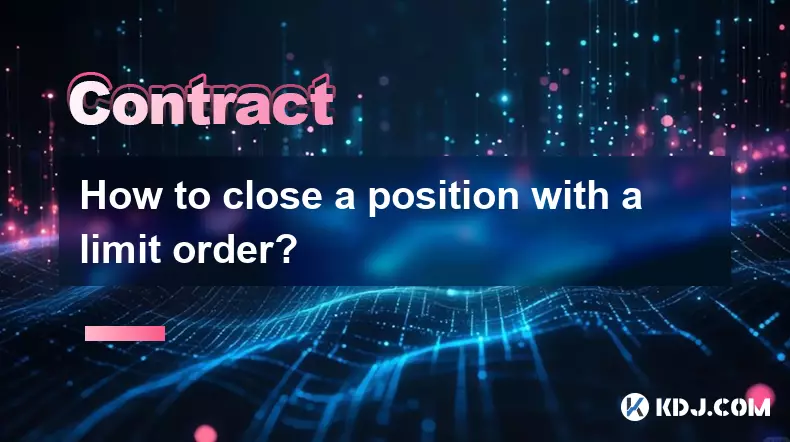-
 bitcoin
bitcoin $123963.239194 USD
1.37% -
 ethereum
ethereum $4529.082464 USD
1.07% -
 xrp
xrp $2.983640 USD
0.71% -
 tether
tether $1.000287 USD
0.02% -
 bnb
bnb $1179.874393 USD
2.99% -
 solana
solana $230.633678 USD
1.55% -
 usd-coin
usd-coin $0.999835 USD
0.03% -
 dogecoin
dogecoin $0.254240 USD
1.34% -
 tron
tron $0.341176 USD
0.15% -
 cardano
cardano $0.842285 USD
0.52% -
 hyperliquid
hyperliquid $48.537896 USD
-0.86% -
 chainlink
chainlink $21.863092 USD
-0.84% -
 ethena-usde
ethena-usde $0.999743 USD
-0.07% -
 sui
sui $3.579561 USD
-0.18% -
 stellar
stellar $0.403418 USD
2.67%
How to close a position with a limit order?
Limit orders let crypto traders set a specific price to buy or sell, offering control over execution but risking non-fill if the market doesn't reach that price.
Sep 21, 2025 at 07:54 pm

Understanding Limit Orders in Cryptocurrency Trading
1. A limit order allows traders to set a specific price at which they are willing to sell or buy a cryptocurrency. When closing a position, this tool gives control over the execution price, helping to lock in profits or minimize losses. Unlike market orders, which execute immediately at the current market price, limit orders only fill when the market reaches the predefined price.
2. Traders use limit orders to close long positions by setting a sell limit above or at a desired profit target. For short positions, a buy limit order is placed to repurchase the asset at a lower price, thus securing gains. This method prevents emotional decision-making by automating the exit strategy based on technical levels or support and resistance zones.
3. The precision of a limit order reduces the risk of slippage during volatile market conditions. In fast-moving crypto markets, prices can fluctuate significantly within seconds. By specifying the exact price, traders avoid unfavorable fills that often occur with market orders during sudden spikes or drops.
4. It's important to note that a limit order does not guarantee execution. If the market never reaches the specified price, the order remains open until canceled or expired. This can be both an advantage and a drawback, depending on market behavior and the trader’s strategy.
5. Advanced trading platforms allow users to attach time conditions to limit orders, such as 'Good-Til-Canceled' (GTC) or 'Immediate-or-Cancel' (IOC). These settings provide additional control, ensuring orders do not linger indefinitely or are executed partially when liquidity is low.
Steps to Close a Position Using a Limit Order
1. Access your trading interface on a cryptocurrency exchange that supports limit orders. Ensure the position you want to close is visible in your open positions tab, showing current unrealized profit or loss.
2. Select the 'Close' or 'Sell' option associated with the open position. Some platforms automatically populate the order size based on the position amount, reducing manual input errors.
3. Choose 'Limit' as the order type instead of 'Market.' This selection enables you to enter a specific price at which you wish to close the trade.
4. Enter the limit price according to your strategy. For a long position, this should be at or above the entry price to secure gains. For a short position, the limit price should be below the entry point to capture profits.
5. Review the order details, including fees, estimated fill time, and potential slippage. Confirm the order only after verifying all parameters match your trading plan.
Risks and Considerations When Using Limit Orders
1. The primary risk is non-execution. If the market moves rapidly past your limit price without touching it, the order may never fill. This is common in trending markets where momentum prevents retracements to target levels.
2. Price gaps due to news or macroeconomic events can bypass limit orders entirely. In highly volatile crypto assets like Bitcoin or meme coins, gaps are frequent, leaving limit orders stranded on the wrong side of the move.
p>3. Partial fills can occur if there isn't enough liquidity at the specified price. This leaves a portion of the position open, exposing the trader to continued market risk until the remaining quantity is closed.
4. Over-reliance on limit orders without monitoring can lead to missed opportunities. Traders must actively manage their orders, especially during high-impact events like exchange listings, regulatory announcements, or protocol upgrades.
5. Placing limit orders too close to the current market price increases the chance of early exit due to minor volatility. Strategic placement requires analysis of average true range (ATR), volatility bands, and recent price action patterns.
Common Questions About Closing Positions with Limit Orders
What happens if my limit order doesn’t get filled?If the market does not reach your specified price, the order remains pending. You can cancel it manually or wait for expiration if a time limit was set. Unfilled orders do not close the position, so exposure continues.
Can I modify a limit order after placing it?Yes, most exchanges allow you to adjust the price or quantity of an active limit order. This flexibility helps adapt to changing market conditions without canceling and re-entering the order, which could affect timing.
Do limit orders work during low liquidity periods?Their effectiveness decreases when liquidity is low. With fewer buyers or sellers at specific price levels, even valid limit prices may not execute due to lack of matching orders on the order book.
Is there a fee for using limit orders?Many exchanges offer lower fees for limit orders compared to market orders because they add liquidity to the market. However, fee structures vary by platform, so it's essential to review the exchange’s pricing model.
Disclaimer:info@kdj.com
The information provided is not trading advice. kdj.com does not assume any responsibility for any investments made based on the information provided in this article. Cryptocurrencies are highly volatile and it is highly recommended that you invest with caution after thorough research!
If you believe that the content used on this website infringes your copyright, please contact us immediately (info@kdj.com) and we will delete it promptly.
- BlockDAG, DOGE, HYPE Sponsorship: Crypto Trends Shaping 2025
- 2025-10-01 00:25:13
- Deutsche Börse and Circle: A StableCoin Adoption Powerhouse in Europe
- 2025-10-01 00:25:13
- BlockDAG's Presale Buzz: Is It the Crypto to Watch in October 2025?
- 2025-10-01 00:30:13
- Bitcoin, Crypto, and IQ: When Genius Meets Digital Gold?
- 2025-10-01 00:30:13
- Stablecoins, American Innovation, and Wallet Tokens: The Next Frontier
- 2025-10-01 00:35:12
- NBU, Coins, and Crypto in Ukraine: A New Yorker's Take
- 2025-10-01 00:45:14
Related knowledge

What is the difference between futures and perpetual contracts for Bitcoin?
Oct 02,2025 at 11:54pm
Understanding Bitcoin Futures Contracts1. Bitcoin futures are derivative instruments that allow traders to speculate on the future price of Bitcoin at...

What is the best time to trade PEPE contracts?
Oct 03,2025 at 11:54am
Understanding PEPE Contract Volatility1. PEPE contracts exhibit extreme price fluctuations due to their meme-based nature and low market cap. Trading ...

What are the common mistakes to avoid with Bitcoincoin contracts?
Oct 03,2025 at 08:54am
Emerging Trends in the Cryptocurrency Market1. Decentralized finance (DeFi) platforms continue to expand their influence across the blockchain ecosyst...

What is the maintenance margin for Bitcoin contracts?
Oct 02,2025 at 01:36am
Decentralized Exchanges Gain Momentum in 20241. Decentralized exchanges (DEXs) have seen a significant rise in trading volume, surpassing centralized ...

How to use technical analysis for trading XRP contracts?
Oct 03,2025 at 01:18pm
Understanding Price Patterns in XRP Futures1. Identifying chart patterns such as triangles, head and shoulders, and double tops or bottoms can provide...

What does "longing" PEPE contracts mean?
Oct 03,2025 at 11:54pm
Understanding Decentralized Exchanges in the Crypto Ecosystem1. Decentralized exchanges (DEXs) operate without a central authority, allowing users to ...

What is the difference between futures and perpetual contracts for Bitcoin?
Oct 02,2025 at 11:54pm
Understanding Bitcoin Futures Contracts1. Bitcoin futures are derivative instruments that allow traders to speculate on the future price of Bitcoin at...

What is the best time to trade PEPE contracts?
Oct 03,2025 at 11:54am
Understanding PEPE Contract Volatility1. PEPE contracts exhibit extreme price fluctuations due to their meme-based nature and low market cap. Trading ...

What are the common mistakes to avoid with Bitcoincoin contracts?
Oct 03,2025 at 08:54am
Emerging Trends in the Cryptocurrency Market1. Decentralized finance (DeFi) platforms continue to expand their influence across the blockchain ecosyst...

What is the maintenance margin for Bitcoin contracts?
Oct 02,2025 at 01:36am
Decentralized Exchanges Gain Momentum in 20241. Decentralized exchanges (DEXs) have seen a significant rise in trading volume, surpassing centralized ...

How to use technical analysis for trading XRP contracts?
Oct 03,2025 at 01:18pm
Understanding Price Patterns in XRP Futures1. Identifying chart patterns such as triangles, head and shoulders, and double tops or bottoms can provide...

What does "longing" PEPE contracts mean?
Oct 03,2025 at 11:54pm
Understanding Decentralized Exchanges in the Crypto Ecosystem1. Decentralized exchanges (DEXs) operate without a central authority, allowing users to ...
See all articles










































































